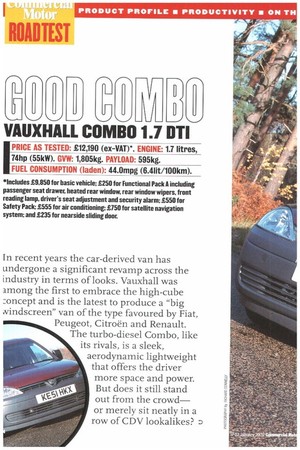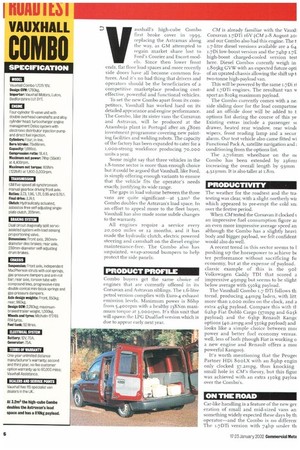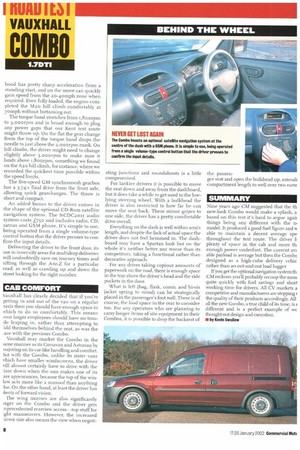VAUXHALL COMBO 1.7 DTI
Page 24

Page 26

Page 28

If you've noticed an error in this article please click here to report it so we can fix it.
I7PRICE AS TESTED: .£12,190 (ex-VAT)*. ENGINE: 1.7 litres, 4hp (55kW). GVW: 1,805kg. PAYLOAD: 595kg. FUEL CONSUMPTION (laden): 44.0mpg (6.41it/100km).
*Includes 19,850 for basic vehicle; £250 for Functional Pack A including passenger seat drawer, heated rear window, rear window wipers, front reading lamp, driver's seat adjustment and security alarm; 1550 for Safety Pack; /555 for air conditioning; 1750 for satellite navigation system; and /235 for nearside sliding door.
In recent years the car-derived van has undergone a significant revamp across the industry in terms of looks. Vauxhall was among the first to embrace the high-cube :oncept and is the latest to produce a "big Nindscreen" van of the type favoured by Fiat, Peugeot, Citroen and Renault. The turbo-diesel Combo, like its rivals, is a sleek, aerodynamic lightweight that offers the driver more space and power. But does it still stand out from the crowd— or merely sit neatly in a row of CDV lookalikes?
auxhalrs high-cube Combo first broke cover in 1993, replacing the Astratnax along the way, as CM attempted to regain market share lost to Ford's Courier and Escort models. Since then lower front ends, flat floor load spaces and more recently side doors have all become common features. And it's no bad thing that drivers and operators should be the beneficiaries of a competitive marketplace producing costeffective, powerful and functional vehicles.
To set the new Combo apart from its competitors, Vauxhall has worked hard on its detailed appearance and engine performance. The Combo, like its sister vans the Corsavan and Astravan, will be produced at the Azambuja plant in Portugal after an LSI:mu investment programme covering new painting facilities and welding robots. The capacity of the factory has been expanded to cater for a 1,000-strong workforce producing 70,000 units a year.
Some might say that three vehicles in the I.8-tonne sector is more than enough choice but it could be argued that Vauxhall, like Ford, is simply offering enough variants to ensure that the vehicle fits the operator's needs exactly, justifying its wide range.
The gaps in load volume between the three vans are quite significant—at 3.2tni the Combo doubles the Astravan's load space. In an effort to appeal more to the fleet buyer, Vauxhall has also made some subtle changes to the warranty.
All engines require a service every 20,000 miles or 12 months, and it has made the hydraulic clutch, electric powered steering and camshaft on the diesel engine maintenance-free. The Combo also has unpainted, wrap-around bumpers to help protect the side panels.
PRODUCT PROFILE
Combo buyers get the same choice of engines that are currently offered in its Corsavan and Astravan siblings. The i.6-litre petrol version complies with Euro-4 exhaust emission levels. Maximum power is 861ip from 5,400rpm with a healthy 138Nm maximum torque at 3,000rpm. It's this unit that will spawn the LPG Dualfuel version which is due to appear early next year. CM is already familiar with the Vauxh Corsavan 1.7DTi t6V (CM 2-8 August 201
and our Combo also had this engine. The t 1.7-litre diesel versions available are a 64 1.7Di low-boost version and the 74hp 1.7E
high-boost charged-cooled version test here. Diesel Combos curently weigh in 1,8o5kg GVW with an expected future opti of an uprated chassis allowing the shift up t, two-tonne high-payload van.
This will be powered by the same r.7Di ii and r.7DTi engines. The resultant van sport an 8rokg maximum payload.
The Combo currently comes with a ne. side sliding door for the load compartme and an offside door will be added to t options list during the course of this ye Existing extras include a passenger se drawer, heated rear window, rear wind( wipers, front reading lamp and a secur alarm. Our test vehicle also came fitted wi Functional Pack A, satellite navigation and ; conditioning from the options list.
The 2,716mm wheelbase on the n( Combo has been extended by 236m1 increasing the overall length by 93mm 4,323 mm. It is also taller at 1.8m.
PRODUCTIVITY
The weather for the roadtest and the tra, testing was clear, with a slight northerly wit which appeared to pre-empt the cold sn: over the festive period.
When CM tested the Corsavan it docked an impressive fuel consumption figure an an even more impressive average speed an although the Combo has a slightly heavi body and bigger payload, we felt confident would also do well.
A recent trend in this sector seems to pushing up the horsepower to achieve be ter performance without sacrificing fu economy, but at the expense of payload. classic example of this is the 901. Volkswagen Caddy TDI that scored a impressive 49mpg but seems to be slight below average with 550kg payload.
The Vauxhall Combo 1.7 DTi follows th trend, producing 44mpg laden, with litt more than L000 miles on the clock, and a extra 45kg payload. Compare this with a 62hp Fiat Dobla Cargo (37mpg and 625k payload) and the 63hp Renault Kangc options (40.2rnpg and 550kg payload) and looks like a simple choice between mot power and better fuel economy versus. well, less of both (though Fiat is working o a new engine and Renault offers a mot powerful Kangoo).
It's worth mentioning that the Peugec Partner H Di 800LX with an 89hp engin only clocked 37.mpg, thus knocking small hole in CM's theory, but this figur was achieved with an extra 130kg payloa over the Combo's.
ON THE ROAD
Car-like handling is a feature of the new ger eration of small and mid-sized vans an something widely expected these days by th operator—and the Combo is no differerr The 1.7DTi version with 7411p under th hood has pretty sharp acceleration from a standing start, and on the move can quickly gain speed from the 20-40mph zone when required. Even fully loaded, the engine completed the M20 hill climb comfortably at 70mph without bottoming out.
The torque band stretches from i,800rpm to 3,000rpm and is broad enough to plug any power gaps that our Kent test route might throw up. On the flat the gear change from the top of the torque band drops the needle to just above the 2, oo orpm mark. On hill climbs, the driver might need to change slightly above 3,000rpm to make sure it lands above r,800rpm, something we found on the A20 hill climb, for instance, where we recorded the quickest time possible within the speed limits.
The five-speed GM synchromesh gearbox has a 3.74:1 final drive from the front axle, allowing quick gearchanges. The throw is short and compact.
An added bonus to the driver comes in the shape of the optional CD-Rom satellite navigation system. The NCDC20rr audio system costs £750 and includes radio, CD, satnav and GSM phone. It's simple to use, being operated from a single volume-type control button that the driver presses to confirm the input details.
Delivering the driver to the front door, its use in inner-city areas for multidrop deliveries will undoubtedly save on journey times and sifting through the A-to-Z for a particular road, as well as crawling up and down the street looking for the right number.
CAB COMFORT
Vauxhall has clearly decided that if you're getting in and out of the van on a regular 3asis then you should have enough space in mhich to do so comfortably. This means Tour larger employees should have no trou)le leaping in, rather than attempting to Old themselves behind the seat, as was the :ase with the previous Combo.
Vauxhall may market the Combo in the iame manner as its Corsavan and Astravan by najoring on its car-like handling and comfort. 3ut with the Combo, unlike its sister vans vhich have smaller windscreens, the driver vill almost certainly have to drive with the isor down when the sun makes one of its are appearances, because the top of the winlow acts more like a sunroof than anything Ise. On the other hand, at least the driver has ilenty of forward vision.
The wing mirrors are also significantly irger on the Combo and the driver gets .nprecedented rearview access—top stuff for .ght manoeuvres. However, the increased airror size also means the view when negoti ating junctions and roundabouts is a little compromised.
For lankier drivers it is possible to move the seat down and away from the dashboard, but it does take a while to get used to the lowlying steering wheel. With a bulkhead the driver is also restricted to how far he can move the seat back. These minor gripes to one side, the driver has a pretty comfortable drive overall.
Everything on the dash is well within arm's length, and despite the lack of actual space the driver does not feel hemmed in. The dashboard may have a Spartan look but on the whole it's neither better nor worse than its competitors, taking a functional rather than decorative approach.
For any driver taking copious amounts of paperwork on the road, there is enough space in the tray above the driver's head and the side pockets in the door.
What is left (bag, flask, comic and hi-vis jacket spring to mind) can be strategically placed in the passenger's foot well. There is of course, the load space in the rear to consider too. For any operators who are planning to carry longer items of site equipment in their Combos, it is possible to drop the backrest of the passen ger seat and open the bulkhead up, extendi compartment length to well over two met
SUMMARY
Nine years ago CM suggested that the th new-look Combo would make a splash, a based on this test it's hard to argue agair things being any different with the ni model. It produced a good fuel figure and v% able to maintain a decent average spe throughout the test route. The driver h plenty of space in the cab and more th enough power underfoot. The current av; able payload is average but then the Combo designed as a high-cube delivery vehic rather than an out-and-out load lugger If you get the optional navigation system th CM reckons you'll probably recoup the mon quite quickly with fuel savings and shori working time for drivers. All CV markets a competitive and manufacturers are steppingi the quality of their products accordingly. All all the new Combo, a true child of its time, is different and is a perfect example of we thought-out design and execution.
• by Kevin Swallow








































































































































